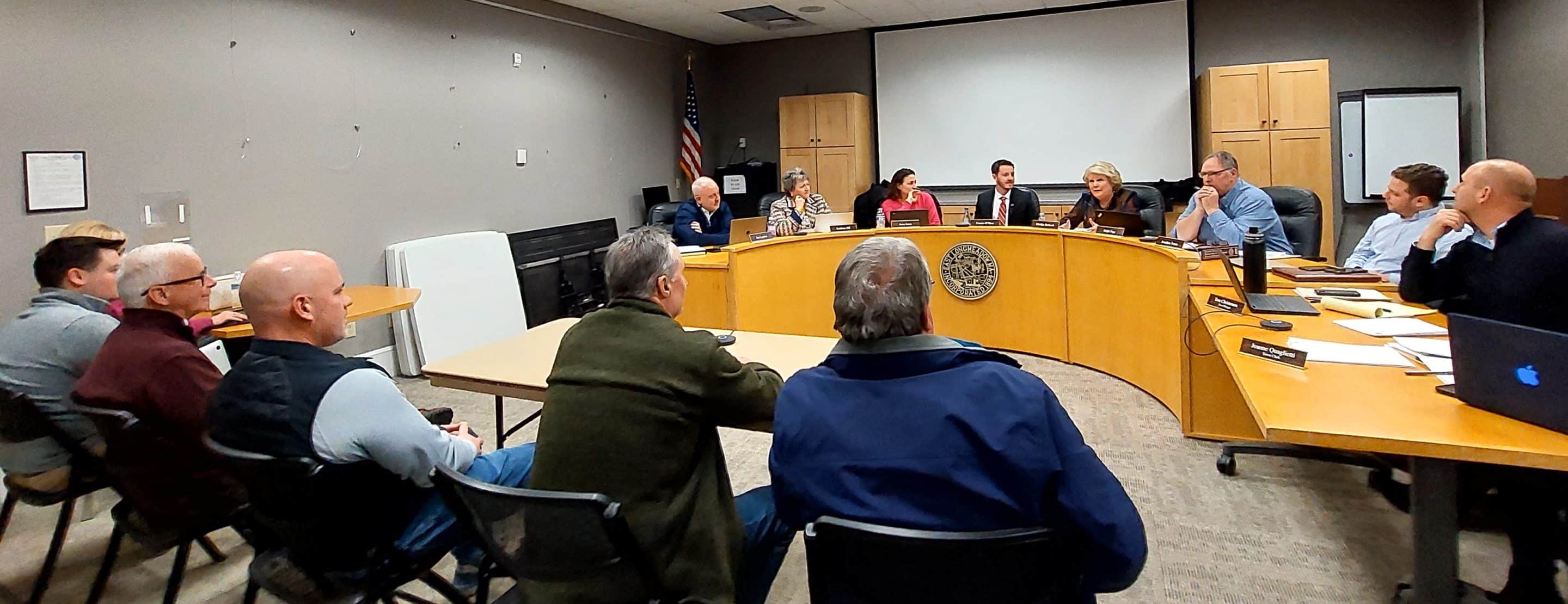The East Longmeadow Town Council and Planning Board discuss the use of state law Chapter 40R in the center town district.
Reminder Publishing photo by Sarah Heinonen
EAST LONGMEADOW — The East Longmeadow Town Council met with the Planning Board on Feb. 11 to discuss the progress made by the Center Town District Steering Committee.
The Center Town District Steering Committee was established by the Town Council and was charged with creating boundaries and a bylaw for a district that would provide a variety of housing options and expand the tax revenue of the properties near the rotary. The steering committee, which includes five voting community members and two ex-officio members, is working with the Pioneer Valley Planning Commission as a consultant on the project.
“Do we like the path that we are going down?” asked Councilor Ralph Page, who serves as an ex-officio member of the committee.
Fellow ex-officio steering committee member Robert Tirrell, who also sits on the Planning Board, said the last meeting had been “pretty productive.” During that Jan. 29 meeting, the committee had begun to consider some of the defining aspects of the center town district, including building height, the types of housing that should be permitted and parking solutions.
Tirrell said people have been “less hostile” than in the past, now that the district boundaries have been to encompass only the rotary, west along Maple Street and south down Shaker Road. He said the process is “going in the right way.”
While everyone present recognized that zoning changes are needed at the center of town and expressed an interest in mixed use parcels, a general sentiment emerged rejecting the state’s involvement in the zoning process. From the beginning, the steering committee has considered the incorporating criteria that would qualify the district for funding under the state’s Chapter 40R regulations. The criteria includes aspects such as density thresholds and 20% of housing units classified as affordable. In exchange for adhering to the regulations of Chapter 40R, communities can receive up to hundreds of thousands of dollars from the state.
“To hell with the money,” said Page. He said the purpose of the process “seemed to have morphed into more of a 40R zone district” rather than a center town district. He added that he wanted the town to write its own bylaw.
“We were always going to write our own bylaw,” Town Manager Tom Christensen said. “The only state involvement is we send an application in with the bylaw, and they say we’re eligible or we’re not eligible.”
However, Page pointed out that the town would have to return the money if the zoning fell out of compliance with Chapter 40R.
Tirrell said that, except for the first couple of meetings, he felt the steering committee had been working toward a town bylaw, rather than one specific to Chapter 40R.
Councilor Jim Leydon said his opposition to the adoption of Chapter 40R criteria had spurred him to run for a seat on the Town Council. He said using the zoning framework would be “putting [the town] in a compromising position by accepting cash payments in exchange for [ceding] local control to Boston bureaucrats.” Leydon said the process of creating the center town district had been “hijacked by personal motives and ambitions,” although he did not name an individual or say what those ambitions were. He added that the unnamed person was trying to “convince East Longmeadow of something they don’t want,” namely, Chapter 40R. Leydon said the process had “run amok.”
Community members who spoke during the meeting also pushed back against state involvement in town zoning. One person recognized, “Change is inevitable,” but added, “We should control our own destiny.” Both Ross Levine and Roland Bolduc expressed concern about increased density.
“It doesn’t make sense to me to overcrowd the center of town,” Punderson said.
Councilor Kathleen Hill commented that the state-mandated allowance of accessory dwelling units is a form of “forced density.” She agreed with the other councilors and Planning Board members that control over the zoning should remain local.
Commercial buildings with housing on the second floor could accomplish many of the town’s goals, Planning Board Chair Russell Denver said.
Planning and Community Development Director Rob Watchilla remarked that single family homes, by far the most common form of housing in East Longmeadow, are being built less frequently as people cannot afford them. He said that, as a 30-year-old, he and his demographic cannot buy single family homes due to the price. Council President Connor O’Shea agreed and said he would need to move out of town to purchase a home. Watchilla said that if the town wants to attract younger residents, it must offer housing they can afford.
Councilor Jonathan Torcia shared similar sentiments. He said he wanted to avoid “pricing people out of this community,” but added that young people are not the only ones unable to find appropriate housing. He observed that people of his parents’ generation want to stay in East Longmeadow but not maintain large properties.
Denver and Planning Board member Peter Punderson said they would prefer housing in the district be marketed toward people with “disposable income.” For Punderson’s part, he said he would not want a young family living next to him.
Denver said the town should not cluster affordable housing into one area because it would not bring economic vibrancy to downtown. Councilor Marilyn Richards noted that Brownstone Gardens, a housing community for residents aged 62 and older, has affordable housing integrated with market rate units. She said developers in the district would need to be “sensitive” to abutters.
Christensen said the town has been in a feasibility process to determine whether Chapter 40R was right for East Longmeadow. If neither board was willing to entertain the framework, then it was time to end consideration.
The Town Council voted to remove Chapter 40R considerations from the Center Town District bylaw process. The Steering Committee’s next meeting was scheduled for Feb. 19.


